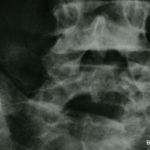 Recent research assessed the efficacy and safety of interleukin (IL) 17 inhibitors in patients with active ankylosing spondylitis (AS). Published in Arthritis Research & Therapy, the study by Yin et al. included a systematic review of randomized, controlled trials using IL-17 inhibitors in AS patients. Researchers then used meta-analyses to determine the efficacy and safety of the IL-17 inhibitors in this patient polution.1
Recent research assessed the efficacy and safety of interleukin (IL) 17 inhibitors in patients with active ankylosing spondylitis (AS). Published in Arthritis Research & Therapy, the study by Yin et al. included a systematic review of randomized, controlled trials using IL-17 inhibitors in AS patients. Researchers then used meta-analyses to determine the efficacy and safety of the IL-17 inhibitors in this patient polution.1
The study’s primary endpoint was predefined as the proportion of patients with at least 20% improvement in the Assessment of SpondyloArthritis International Society response criteria (ASAS20) at week 16. Its secondary endpoint was defined as the proportion of patients achieving an ASAS40 response at week 16.
The study initially found 3,051 relevant citations, identifying five published articles and six clinical trials. All studies were phase 3, double-blind, placebo-controlled, randomized trials. In the studies, 1,733 patients enrolled received secukinumab or ixekizumab (1,153 patients received an IL-17 inhibitor, and 580 patients received placebo). Four of the clinical trials examined secukinumab, with 777 patients receiving secukinumab and 389 patients receiving placebo. Two of the clinical trials examined ixekizumab, with 376 patients receiving ixekizumab and 191 patients receiving placebo.
Dosing varied by clinical trial. Ixekizumab was administered in 80 mg doses every two or four weeks, with or without loading doses. Secukinumab was given in 75 mg, 150 mg or 300 mg doses every four weeks, with or without loading doses. In the trials, patient ages ranged from 40 ± 11.6 years to 46.6 ± 12.7 years. More than half of the secukinumab- and ixekizumab-treated patients were male.
The Results
The primary endpoint was met by 58% of secukinumab-treated patients and ixekizumab-treated patients, compared with 35% of placebo-treated patients. In a subgroup analysis, both ixekizumab and secukinumab were found to be superior to placebo.
ASAS20 was achieved at week 16 by 58% of secukinumab-treated patients vs. 36% for placebo-treated patients (P<0.001). ASAS20 was achieved at week 16 by 56% of ixekizumab-treated patients vs. 35% for placebo-treated patients (P<0.001). Similar differences in IL-17 inhibitors compared with placebo were seen for the secondary endpoint, which was met by 37% of ixekizumab- and secukinumab-treated patients vs. 18% of placebo-treated patients (P<0.001).
Overall, adverse events were more common in the active treatment groups (57%) than in the placebo groups (51%). More non-severe infections occurred in IL-17 inhibitor-treated patients (27% vs. 15% for placebo-treated patients; P<0.001), which included mild or moderate upper respiratory tract infections and nasopharyngitis. Additionally, no increased risk in other adverse events, such as death, discontinuation due to adverse events or serious adverse events, was shown following treatment with IL-17 inhibitors.



